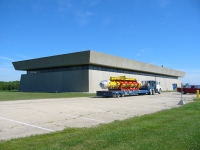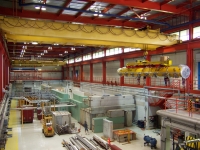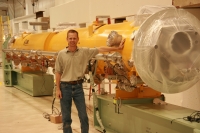 |
 |
|||||||||||||
|
|||||||||||||
|
|||||||||||||
|
Good news from an experimental hall at the edge of the prairie: Fermilab's ILC test area in the 'New Muon Lab' (NML) has just taken a major step towards completion with the installation of the first cryomodule on 6 August.
The test area, once complete, will represent one full RF unit of the ILC. This means there will be three full cryomodules powered by a 10-MW RF system, a cryogenic system capable of achieving temperatures of 2K and an injector beam line consisting of an electron gun and an accelerating capture cavity. The installation of the first phase of the project includes the first cryomodule, capture cavity, their respective RF power sources and the cryogenic system. “The cryogenic infrastructure is nearing completion, so it was time to move the cryomodule in,” says Jerry Leibfritz, Project Leader of the ILCTA. “Now we are looking forward to connecting it all up and running a first test.” The waveguide system, designed and built at SLAC, is scheduled to arrive later this month and the plan is to be ready to begin cooling down the first cryomodule around December and to begin RF tests in the spring of 2009. And it's not only the RF acceleration that can be tested once the full set-up is complete, but also the control systems, diagnostics, and instrumentation. There are also future plans for advanced accelerator R&D testing at the NML facility, including components such as crab cavities — a special type of cavity that gives the beams a flick just before the collision to make them collide sideways instead of head-on, thus increasing the collision rate. Many were involved in the move of the cryomodule from Fermilab's Cryomodule Assembly Facility (CAF) to NML and even more watched it getting lowered into the test cave. Mike McGee, Fermilab's expert on cryomodule transport and vibration studies, continually monitored the forces and vibrations the cryomodule experienced during its two-mile transport across Fermilab. The module that moved in has a story of its own. Like a model plane assembly kit or a new shelf from IKEA, the full module arrived labelled down to the last screw and stored in boxes and containers. Its origin: DESY in Hamburg. People at DESY already know how to build these yellow giants because of their own test accelerator FLASH that uses almost identical modules. So they put one aside, packed it up and shipped both the parts and themselves over to Fermilab to pass on their expertise and find out whether their instructions worked. “We are excited to finally see the 'kit' module in action,” says Kay Jensch from DESY who was involved in planning and supervising the assembly adventure. The second phase of the NML project will see the installation of the second cryomodule and the injector for the beam, while part of the third phase may never get beyond the planning stage. For a full RF unit, the test accelerator needs the third cryomodule. “The plan had been to extend the building to house the third module and the full injector,” explains Leibfritz. “We were planning on building a twin tunnel extending from the existing building into the corn fields to the North that could have housed a second RF unit in the future.” But then the funding was cut and the plans had to be changed to keep progress moving forward, so now all three cryomodules will be put into the existing NML building. “It means that we had to shrink and simplify the injector. The beam will still have the same average beam current as the ILC, but it'll lack some of the other features,” Leibfritz says. “Hopefully, the budgets will be restored in the future and we can return to our original plan of building a world-class test facility for the ILC.” -- Barbara Warmbein |
|||||||||||||
| © International Linear Collider |


